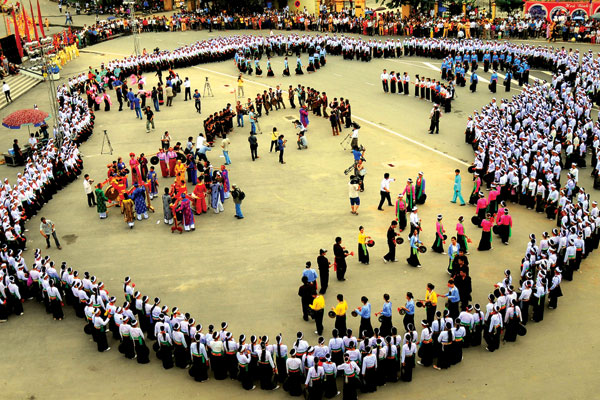(No.9, Vol.6,Nov-Dec 2016 Vietnam Heritage Magazine)

Photos by Nguyen Phung Chi at the Gong Festival in Hoa Binh Province, 2011. The festival had 1,500 performers and is listed in the Vietnam Book of Records as the biggest gong performance in Vietnam
The gong has
many uses among
the Muong
Gongs are the means to communicate with the sublime, to say farewell to the souls of the deceased that are going to meet the ancestors, to heat up festive gatherings, to expel evil spirits, to bless newlyweds, to signal pillage raids, or to call a lover that is mountains away.
Those are the typical uses of this 2,700-year-old percussion instrument in the spiritual and daily life of the ancient Muong tribe of Hoa Binh Province. Currently, there are about 1,300,000 Muongs, living mostly in Hoa Binh Province and scattered in the Northwest and in Thanh Hoa Province.
In 1932, Hoa Binh suddenly became famous because foreign archaeologists found a large amount of over-15,000-year-old human remains and stone tools of the early Stone Age.
A treasure protected for thousands of years
Legends have it that, since immemorial times, the Muongs have found that stalactites in the caves give out cheery sounds when hit. After the discovery of bronze, they cast gongs, as rudimentary as the stalactites themselves.
Texts in the Hoa Binh provincial museum say that gongs appeared in the province during the 2-5th centuries.
Muong gongs, apart being used for the above mentioned purposes, are also a symbol of wealth and power of a clan. ‘For such important role in their daily and spiritual life, the Muongs consider gongs as a sacred treasure,’ according to Muong culture expert Mr Bui Chi Thanh.
As sacred as they are, the gongs are nevertheless a household item of the Muongs. ‘While the bronze drums are a sacred item for the nobility and big parties, gongs are larger and are present in villages and families as the voice of the simple Muong people. The image and sound of gongs accompany Muong people all their lives and are a cherished part of their souls.’ That’s the opinion of Mr. Bui Tu Cao from the dept. of Culture Sports and Tourism of Hoa Binh Province. Each Muong family strived to have a gong. ‘Before 1945, almost every household, however poor they might be, had a gong as a family treasure. The wealthy families usually had 1-2 sets of gongs, each consisting of 12 items (representing the 12 months), hung around the house to show off their status,’ according to the Hoa Binh Province media authority.
‘Hoa Binh Province currently has nearly 10,000 gongs, mostly concentrated in Kim Boi, Lac Son, Tan Lac, Da Bac Districts and Hoa Binh city,’ according to the Website of the Dept. of Culture Sports and Tourism of Hoa Binh Province.
‘Particularity’ of Muong gongs
According to Vietnamese culture experts, ethnic groups living in Vietnam’s highlands have devised gongs since the Bronze Age, about 2,700 years ago.
They also say that ‘gong culture space,’ which includes the gongs, gong tunes, gong players and community activities involving gongs of different ethnic groups, though quite similar, carry quite some distinct particularities.
The most famous ‘gong culture space’ is the Tay Nguyen highlands, including Kon Tum, Dak Lak, Dak Nong and Lam Dong provinces. It has been recognized by UNESCO as a Masterpiece of Oral and Intangible Heritage of Humanity.
There is no comparison between the ‘gong culture spaces’ of Tay Nguyen and Hoa Binh. Experts of Hoa Binh culture simply say that the Muong people own a huge collection of gongs and gong tunes, and their presentation is also very unique.
‘Hoa Binh Province Muong gong music is the convergence of nature and life. Its rhythmic tunes can smoothly sink into the depths of the heart, or arouse it to action. It’s best to listen from a distance, in a spring, a terraced field, or a stilted house,’ according to Muong culture experts.
The most distinctive feature of ‘Muong gong culture space’ is that women play them instead of men. Old texts recorded that some Muong festivals involved 1,000 Muong women playing 1,000 gongs, creating a one-of-a-kind picture of colours and sounds uniquely peculiar to this ethnic culture.
The performance on the largest scale done by Muong people recently took place in 2011 to celebrate 125 years of Hoa Binh Province. This performance, titled ‘Precious carrier – sacred spirit,’ was listed in the Vietnam Book of Records as the ‘biggest gong performance of Vietnam.’
The Hoa Binh provincial government currently pays a lot of attention to the research, collection, preservation and development of the values of Muong gong culture space. They are also suggesting that the Vietnamese government recognize the ‘Muong gong culture spaces’ as a national intangible heritage.

